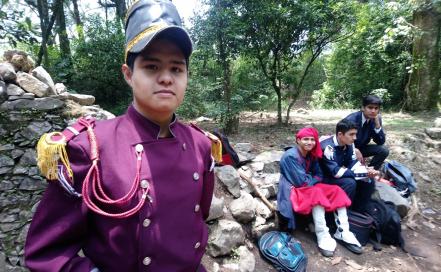Más Información

Noroña respalda fallo del TEPJF sobre elección judicial; Senado alista acuerdo para definir en tómbola candidaturas

Sheinbaum: “Hay muchas leyes que vamos a presentar”; alista paquete de reformas “muy trascendentes” para Pemex y CFE

Anuncian 100 mil apoyos de mejoramiento de vivienda para el oriente de Edomex; estos son los requisitos

Decisión del TEPJF quita pretexto para impugnar elección: Sheinbaum; acusa que SCJN quiere impedirla

Profeco revisa quejas de reembolso por “Emilia Pérez”; llama a Cinépolis a “recomendar” en vez de “garantizar” películas

Vinculan a proceso a “El Chavo Félix”, yerno de “El Mayo” Zambada; lo detuvieron con pastillas de fetanilo
During the night, at the highest part of Cerro del Borrego , a group of French soldiers surprises and kills a battalion of between 700 and 2000 Mexican soldiers in their sleep, before the astonished gaze of tenths of bystanders.
On the 5th of May 1862, Mexican troops had basked in their glory after defeating the soldiers of the Second French Empire in the city of Puebla. Over a month after, death and defeat overcame the victorious soldiers atop the hill Cerro del Borrego, located in the highlands of the Orizaba municipality, in the state of Veracruz.
“Hardly anyone pays tribute to the soldiers that gave their lives defending their homeland,” said acting professor José Miguel Conde who, with the help of a group of young actors, reenacts the fateful “battle” of 13th June around this time of the year. A battle that meant the defeat of Mexico and the establishment of the second French intervention in the country.

One of the actors gives life to the General Jesús González Ortega , who was ordered to transfer the troops to Cerro del Borrego with the purpose of definitely expelling the French army, which had suffered one of their most shameful defeats in Puebla on the 5th of May, a historical date for the people of Mexico.
General Ignacio Zaragoza
, who took credit for the Battle of Puebla , ordered his soldiers to go across Perote so that the army could move towards the north of Orizaba and take the split of the mountain range in Cerro del Borrego to eventually attack the invaders.
“Those men are hardly remembered and we try to honor them so that people realize their importance”, said Conde.
The legend, which is reenacted step by step by these young men, tells that there was a traitor who gave the exact location of the Mexican troops , and while they slept at one o'clock in the morning, they were taken by surprise and massacred by the French.
“Between seven hundred and two thousand of our soldiers died because of that betrayal,” explains the Professor, who has learned by heart the events that tinged the summit with blood. Today, the hilltop is a tourist center harboring the 3000 feet long Orizaba funicular railway , which is the third longest railway in Mexico.

The failure of the advance party in Orizaba meant the last real opportunity for the Mexican army to put an end to the intervention. On March 16, 1863, less than a year after their defeat, 30 thousand French soldiers started the siege of Puebla, leading to their victory on May 17.
To Armando López Macip, member of the National Academy of History and Geography, the Battle of Cerro del Borrego was “a disgrace for the country” and a “massacre.”
“It was a moonless night; darkness and confusion reigned during battle. Stealthily, the French seized the cannons and fired against the Mexicans”, described Macip in a conference hosted by the Veracruz Institute of Culture.
Nevertheless, he disagrees with regard to the death toll. He considers that there were actually 250 Mexican soldiers and states that the massacre was a turning point between the victory achieved in Puebla on May 5 and the establishment of Maximilian of Habsburg in the Mexican government.
At the top of the hill lie not only the ruins of the fort but also a museum which houses images, remains, and items from the fateful battle such as muskets, battered banners, and blood-stained uniforms.
dm



